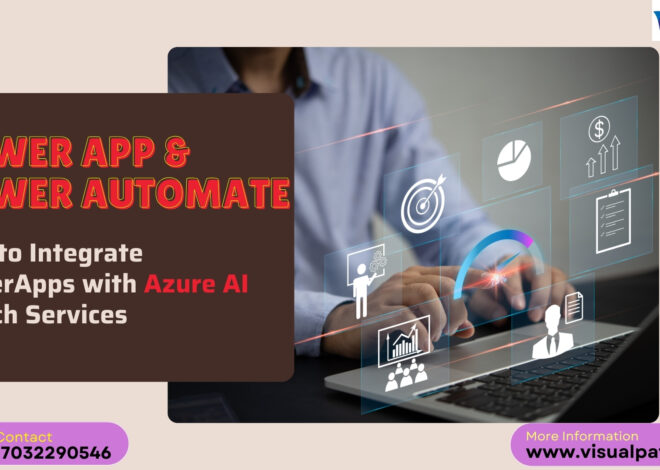PowerApps Training: Key Features You Learn in These Courses
PowerApps Training is an essential step for individuals and organizations looking to harness the power of Microsoft’s low-code development platform. This training focuses on equipping learners with the skills needed to create custom applications without requiring extensive coding knowledge. In today’s fast-paced digital world, companies are leaning towards solutions like PowerApps Training to streamline operations and increase productivity. Complementary to this, Power Automate Training is often integrated to teach how workflows can be automated seamlessly across various business functions.
By enrolling in PowerApps Training, professionals can build interactive apps, automate repetitive tasks, and connect with numerous data sources. Alongside this, many courses offer insights into Power Automate Training, which teaches the automation of workflows between apps and services to improve business efficiency. These combined skills are invaluable for modern businesses looking to adopt low-code tools effectively.
Key Features Taught in PowerApps Training
1. App Development with No-Code or Low-Code
A primary focus of PowerApps Training is learning to develop functional and interactive apps with minimal coding. Participants explore the PowerApps Studio interface, where they can create forms, dashboards, and applications using drag-and-drop functionality. This approach is ideal for professionals without a programming background, enabling them to design apps tailored to their organization’s needs.
Through this training, learners gain hands-on experience in creating applications for mobile and web platforms. These apps can be integrated with databases like Microsoft Dataverse, SharePoint, or SQL Server. Additionally, Power Automate Training complements this feature by allowing users to link these apps with automated workflows, adding efficiency to the processes.
2. Understanding and Utilizing Data Integration
Data plays a critical role in building applications, and PowerApps Training ensures participants are well-versed in connecting apps to various data sources. From cloud-based solutions like OneDrive, Azure, and Google Drive to on-premise databases, learners acquire the knowledge to integrate data securely and efficiently.
Moreover, integrating Power Automate Training into this curriculum enables users to automate the flow of data between applications. For instance, creating a process that automatically updates a database entry when a form is submitted becomes effortless. This synergy between PowerApps and Power Automate ensures robust data management.
3. Customization and UI Design
Customizing applications to meet specific organizational requirements is a crucial aspect taught in PowerApps Training. Participants learn how to design user-friendly interfaces and add components like buttons, text fields, and dropdown menus. Training also includes advanced customization techniques such as incorporating conditional formatting and responsive layouts to enhance user experiences.
Power Automate Training further enhances this by teaching how automated notifications or data updates can integrate with app functionalities, ensuring a seamless end-user experience.
4. Workflow Automation with Power Automate
While PowerApps Training primarily focuses on app creation, many courses also introduce Power Automate Training to showcase how workflows can be optimized. Learners explore tools to create workflows that perform actions like sending email alerts, updating databases, or generating reports automatically. By combining PowerApps and Power Automate, businesses can build a cohesive ecosystem that integrates apps and workflows for maximum productivity.
For instance, a retail company might use PowerApps to track inventory and Power Automate Training to set up alerts when stock levels fall below a certain threshold. This combination saves time and reduces manual errors, showcasing the value of mastering both platforms.
5. Security and Role-Based Access Control
Security is a top concern for organizations, and PowerApps Training covers the implementation of role-based access control (RBAC). Participants learn to configure permissions, ensuring that users can only access data and features relevant to their roles. This training ensures that applications comply with organizational security policies.
Additionally, Power Automate Training complements this by teaching how to secure automated workflows. For example, workflows can be configured to require authentication steps or approvals before executing sensitive actions.
6. Deployment and Maintenance Best Practices
Another critical feature taught in PowerApps Training is deploying and maintaining applications. Learners are introduced to techniques for publishing apps within their organization or on a larger scale. The training also includes troubleshooting and updating apps to align with evolving business needs.
Similarly, Power Automate Training teaches how to monitor workflows, identify potential bottlenecks, and optimize processes over time. Together, these courses prepare learners to implement scalable and sustainable solutions.
Why Combine PowerApps Training with Power Automate Training?
While PowerApps Training provides the foundation for building custom applications, Power Automate Training ensures that these applications operate efficiently through automated workflows. By mastering both tools, individuals can create dynamic, integrated systems that streamline business operations. This combination is especially valuable for businesses seeking to maximize their return on investment in the Microsoft Power Platform.
For example, an HR department might use PowerApps to create a recruitment app and Power Automate to automate notifications and approvals. Together, these tools enable faster decision-making and improved process transparency.
Conclusion
Enrolling in PowerApps Training equips professionals with the skills needed to design powerful, low-code applications that address specific business challenges. The training covers critical aspects like app development, data integration, customization, and deployment. By combining this with Power Automate Training, learners gain the ability to automate workflows, creating a comprehensive solution for modern businesses.
Whether you’re a developer, IT professional, or business analyst, mastering these platforms opens doors to building innovative and efficient solutions. Invest in PowerApps Training and Power Automate Training today to stay ahead in the rapidly evolving digital landscape.
Visualpath is the Leading and Best Institute for learning in Hyderabad. We provide PowerApps and Power Automate Training. You will get the best course at an affordable cost.
Attend Free Demo
Call on – +91-9989971070
Blog: https://visualpathblogs.com/
What’s App: https://www.whatsapp.com/catalog/919989971070/
Visit: https://www.visualpath.in/online-powerapps-training.html




